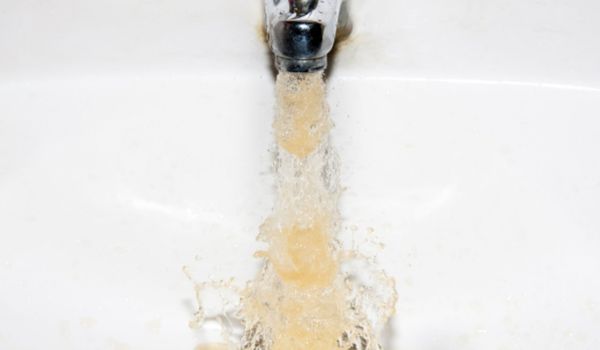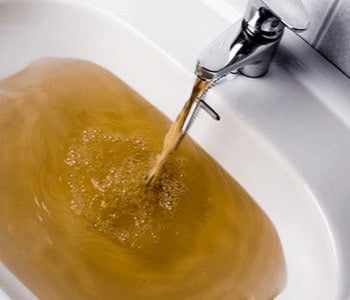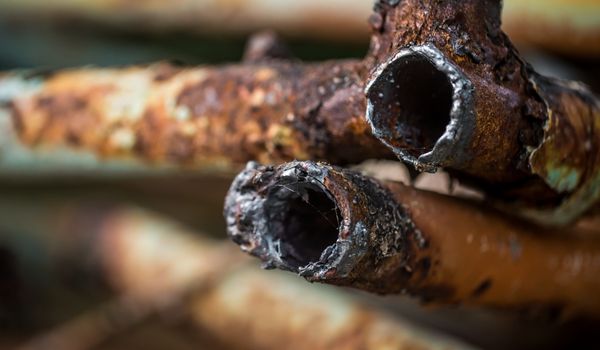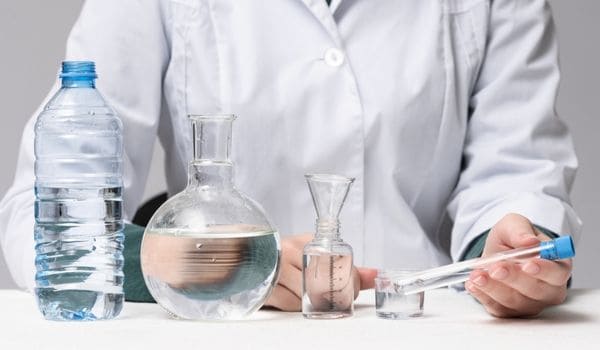Yellow is a great color for sunflowers and rain boots — not so much for the water coming out of your faucet.
If your tap water looks more like weak tea than clean drinking water, something’s off. The good news? Not all yellow water is dangerous. But it is trying to get your attention — and in some cases, it can signal deeper plumbing or contamination problems.
We’ll walk you through the most common causes — how to tell if it’s serious, and what to do about it.
✅ Key Takeaways
- 🚰 Yellow water usually comes from minerals like iron, manganese, or sediment buildup
- 🔧 It can also be caused by corroded plumbing or water heater issues
- 🌾 Well water may contain tannins, iron bacteria, or organics
- 💡 Color alone doesn’t tell you if water is safe — testing is the only way to know
- 🛠️ Most causes can be solved with a well-matched filtration system
⚠️ Is Yellow Water Safe To Drink?

Sometimes yes — sometimes no.
A slight yellow tint from minerals like iron or manganese usually isn’t dangerous. But if the color is new, worsening, or comes with odor, taste changes, or low pressure, it could point to something more serious.
- Sudden change? Could signal rust, a burst pipe, or bacterial contamination
- Smells musty or swampy? Might be iron bacteria
- Yellow + low pressure? Call your water supplier — it could be a ruptured main
- On a well? Tannins or organics may be the culprit — but test to be sure
👉 If you’re unsure, don’t drink it until you’ve tested it. Most yellow water problems are easy to fix once you know the source.
🏙️ Why Is My City Water Yellow?

City water is usually crystal clear — so if it suddenly turns yellow, there’s likely a disturbance somewhere in the distribution system. Here are the most common causes:
🚧 Burst Pipes or Repairs
A ruptured main line or nearby pipe repair can stir up rust and sediment that normally settles in the system. If your tap water is yellow and your pressure has dropped, contact your local water utility — they may be working on a line nearby.
💡 If there’s a boil order in effect, always follow it until your provider gives the all-clear.
🚿 Routine Water Line Flushing
Utilities sometimes flush hydrants or water mains to clear out sediment. This can temporarily increase pressure and dislodge rust, making your cold water appear yellow. It usually clears up within a few hours.
🌾 Why Is My Well Water Yellow?
Wells draw from groundwater that passes through soil, rock, and organic material — which means they’re more likely to pick up minerals and natural discoloration. Here’s what might be turning your water yellow:
🍂 Tannins

If your water looks like weak tea and stains your laundry or toilet bowl yellow, tannins could be the issue.
These plant-based compounds come from decaying leaves and organic debris.
- Found in areas with swampy soil or heavy vegetation
- Turns water yellow, brown, or golden
- Harmless but hard to remove
- Leaves behind stains in sinks and fabrics
Fixing it: Requires a specialized tannin filter — carbon filters may help but usually aren’t enough on their own.
⛏️ Iron & Manganese
These metals occur naturally in groundwater and are some of the most common causes of yellow, orange, or brown well water.
- Low levels turn water pale yellow
- High levels create rusty or blackish tint
- Stains appliances and clothes
- Can clog plumbing and reduce flow
Fixing it: Oxidizing filters or ion exchange systems can remove both — depending on whether the iron is dissolved or in rust form.
🦠 Iron Bacteria
This slimy troublemaker isn’t harmful to drink — but it’s a major nuisance. Iron bacteria feed on iron in the water and produce a yellow-orange sludge that clings to pipes and smells like musty pond water.
- Often shows up with iron in the water
- Leaves sticky deposits in toilets, faucets, and tanks
- May cause odor or clog filters
- Not dangerous, but may indicate poor water hygiene
Fixing it: No filter alone can remove iron bacteria — shocking your well or installing a chlorination system may be needed.
🧪 Copper or Zinc
Less common, but still possible — copper and zinc can get into your well water through corrosion of pipes, fixtures, or even naturally occurring deposits.
- Can cause yellow tint + metallic taste
- Often linked with acidic water (low pH)
- Rarely dangerous at low levels, but worth monitoring
Fixing it: Start by testing — if metals are present, a pH neutralizer and heavy metal filter may be recommended.
🛠️ Could Your Plumbing Be the Problem?

Yellow water doesn’t always come from your source — sometimes, the problem is hiding inside your own plumbing. Even if your supply is clean, rust, corrosion, or buildup in pipes and fixtures can tint your water as it flows through.
🚰 Corroded Faucets or Aerators
If only one tap is affected, the faucet itself might be the issue. Over time, metal fixtures can corrode from the inside — even if they look fine on the outside.
- Common in older homes with outdated materials
- Rust can flake off and discolor water
- Aerators trap sediment and debris
- Easy to overlook because damage is internal
Fixing it: Remove and inspect the faucet or aerator. If corroded, replace it — a quick and inexpensive fix.
🧱 Rusty Pipes
Yellow water at multiple taps could point to internal pipe corrosion. Older galvanized or cast iron plumbing is especially prone to rust, which can discolor your water supply.
- Yellowing is often worse after water sits in the pipes
- Hot and cold water may both be affected
- Staining on fixtures or in toilets is common
- Replacing old plumbing is the most permanent fix
Fixing it: A short-term solution may be flushing your lines or using a point-of-use filter, but pipe replacement is often needed long-term.
🔥 Water Heater Issues
If only your hot water looks yellow, the issue may be in your water heater — especially if it’s older or hasn’t been flushed in a while.
- Sediment buildup can discolor water
- Rusty anode rods may be breaking down
- Hot water often stirs up settled minerals
Fixing it: Try flushing the tank. If that doesn’t help, have a plumber inspect the heating element or consider replacing the unit if it’s beyond repair.
🧪 Should You Test Yellow Water?

If your pipes and fixtures check out — or if you’re on well water — testing is the next smart step.
Yellow water can come from harmless minerals, but it could also be linked to bacteria, metals, or pH problems. And since color alone doesn’t confirm what’s in your water, a proper test is the only way to know for sure.
🧾 What You’ll Learn from a Water Test:
- Whether yellow tint is from iron, manganese, tannins, or sediment
- If your water is acidic (low pH), which can cause pipe corrosion
- If there are any bacterial or chemical contaminants present
For public water users, your city may test regularly — but issues can still happen between the treatment plant and your tap. If you use a private well, testing is entirely your responsibility.
🧪 Pro Tip: Use a Lab-Based Kit You Can Trust
We recommend a water test. It’s DIY-friendly and backed by certified labs. You’ll get:
- A kit with everything you need
- Lab results with easy-to-read explanations
- Personalized treatment recommendations (with no brand bias)
Whether you’re testing for tannins, metals, or bacteria, this kit takes the guesswork out of yellow water.
💧 How to Fix Yellow Water at Home

Once you know what’s causing the discoloration, it’s usually easy to treat — especially with the right filter. Whether the issue is sediment, tannins, or iron, here’s a breakdown of which systems actually work:
| 🧰 System Type | 💛 Treats Yellow Water From | 🔍 Notes |
|---|---|---|
| Activated Carbon Filter | 🌿 Tannins, chlorine, organic matter | Also improves taste and odor; great for mild discoloration |
| Oxidizing Filter | ⛏️ Iron, manganese (dissolved or rust) | Best choice for removing orange/yellow tint from metals |
| Ion Exchange (Softener) | ⚙️ Low levels of iron, manganese, and tannins | Helps with both yellowing and hard water issues |
| Reverse Osmosis | 🧪 Metals, tannins, sediment (at the tap) | Great for drinking water but not ideal for whole-home discoloration |
| pH Neutralizer | 🍋 Acidic water causing corrosion | Prevents yellowing from pipe leaching and improves plumbing lifespan |
🧰 How Each Filtration System Solves Yellow Water Issues

Once you know the cause, the right filter can fix the issue — whether it’s minerals, organics, or corrosion. Here’s how the most common systems stack up:
🧰 Activated Carbon Filters
If your water smells off, tastes funny, or has a yellow tint from organics or mild contamination, carbon is a great starting point. It’s affordable, widely available — and super effective at polishing up drinking water.
- Removes chlorine, tannins, organics, and sediment
- Improves taste, odor, and clarity
- Found in pitchers, undersink systems, and whole-house filters
- Works best on city water or shallow wells with organics — not ideal for dissolved metals
Pro Tip: If you’re using a carbon filter for well water, look for a system rated for tannins — not all carbon filters can handle them.
⚙️ Ion Exchange Filters (Water Softeners)
If your yellow water problem comes from low levels of iron, manganese, or tannins — especially alongside hard water — a softener might be your solution. These systems use resin beads to swap minerals for: sodium or potassium, reducing discoloration and scale buildup.
- Removes calcium, magnesium, and some iron/manganese
- Some softeners can reduce low levels of tannins with the right resin
- Best for whole-home treatment when yellowing comes with hardness
- Won’t work on high iron or sulfur levels without pre-treatment
Pro Tip: Not all softeners are built the same — check the specs for iron or tannin reduction before assuming it’ll solve discoloration alone.
⛏️ Oxidizing Filters
If your water turns yellow from iron or manganese — especially in dissolved form — oxidizing filters are your best bet. These systems use: air, chlorine, or other agents to convert clear dissolved metals into solid particles that can be filtered out.
- Removes ferrous (dissolved) iron, ferric iron (rust), and manganese
- Works well on yellow, orange, or even black discoloration
- Often combined with sediment or carbon filters for polishing
- Typically installed as a whole-house system
Pro Tip: If you’re dealing with rotten egg odor or iron bacteria, oxidation may need to be paired with chlorination or a disinfecting system for full control.
🔬 Reverse Osmosis (RO) Filters
RO systems are excellent at polishing up drinking water — especially when yellow tint is caused by trace metals, tannins, or other dissolved solids. But they’re not ideal for whole-house treatment, and they need protection from heavy iron or sediment.
- Removes dissolved minerals, tannins, metals, and some organics
- Delivers ultra-pure water at the kitchen tap
- Typically installed under the sink
- Not effective for treating iron bacteria or large amounts of rust
- Requires pre-filtration (sediment/carbon) to protect the membrane
Pro Tip: If your test shows iron levels above 0.3 ppm, pre-treat with a softener or oxidizer before using RO — or you’ll burn through membranes fast.
🦠 Treating Yellow Water from Iron Bacteria

If your water has that slimy, orange-yellow buildup — especially with a swampy or musty smell — iron bacteria could be the cause. It thrives in: wells with iron and manganese, forming biofilm that clogs pipes and stains everything.
Unfortunately, no standard filter can remove it once it’s in your plumbing.
- Leaves slimy yellow-orange sludge in toilets, tanks, and pipes
- May clog filters or reduce water pressure
- Gives off earthy, pond-like odors
- Can make water look yellow, orange, or cloudy
Fixing it:
- You’ll need to shock your well with chlorine to kill the bacteria
- In stubborn cases, continuous disinfection (e.g. chlorinator + carbon filter) may be needed
- Consider hiring a pro — this is one issue that’s tough to DIY long-term
Pro Tip: If iron bacteria keeps coming back, test for coliforms too — it’s often found in the same conditions.
✅ Final Thoughts
Yellow water isn’t always dangerous — but it’s never something to ignore.
Whether it’s minerals, tannins, pipe corrosion, or iron bacteria, there’s always a reason your water changed color. Testing is the fastest way to find the cause — and from there, the fix is usually simple.
The good news? Most yellow water issues can be solved with the right filtration system — no bottled water, guesswork, or stress required.
 99 people found this helpful. Was this guide helpful to you?
99 people found this helpful. Was this guide helpful to you? 

